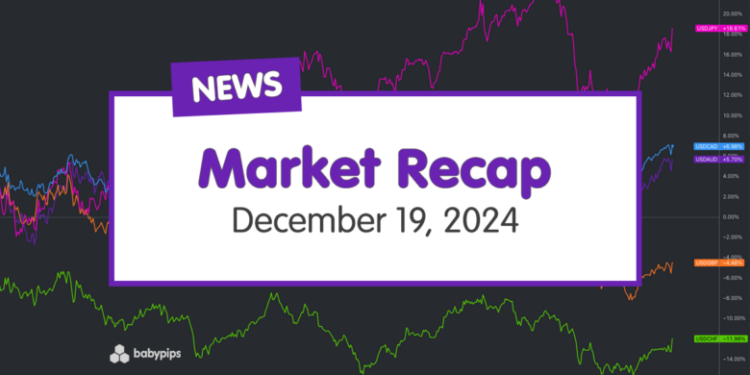On Thursday, the financial landscape was shaken by the Federal Reserve taking a less dovish stance, but it was the Bank of Japan’s decision to hold steady and the unexpected vote by the Bank of England that truly stole the limelight, adding a dose of volatility to major assets.
In the aftermath, the dollar jumped up, gold plummeted to its lowest in six days, oil prices dropped amid demand concerns, and Bitcoin took a step back as traders tried to make sense of the sudden shifts in central bank strategies coupled with stronger U.S. economic data.
Let’s delve into how the recent trading unfolded for your go-to assets!
### Headlines:
Inflation expectations in Australia rose to 4.2% in December from 3.8% previously, marking the highest since September. In New Zealand, the ANZ business confidence index dropped to 62.3 in December from 64.9. Notably, their pricing indicators and inflation expectations remained mostly identical. The Bank of Japan maintained its interest rate at 0.25% with an 8-1 vote, opting to wait on more data regarding Japanese wages and U.S. policy before deciding on future interest rate changes. Meanwhile, Switzerland’s trade surplus dwindled from 8.03B CHF to 5.42B CHF as exports nosedived by 11.0% compared to a 3.6% drop in imports for November. The Bank of England held rates steady at 4.75%, though the 6-3 vote split raised eyebrows and put pressure on the pound. In the U.S., GDP growth for Q3 was adjusted upwards to 3.1% from an earlier estimate of 2.8% quarter-over-quarter, with Core PCE also revised up to 2.2%. Initial jobless claims for the week ending December 17 came in at 220K, showing improvement from the previous 242K. Meanwhile, the Philadelphia Fed Manufacturing Index plummeted to -16.4 for December, the lowest since April 2023.
### Broad Market Price Action:
The Federal Reserve’s hawkish undertone from Wednesday continued to loom over market participants, as they dialed back expectations for rate cuts in 2025 from four to just two, pointing towards a prolonged period of elevated rates. This heightened expectation, backed by a stronger Q3 GDP at 3.1%, pushed Treasury yields to a noticeable six-month high of 4.57%. Adding to the mix, the Bank of Japan’s dovish decision and the BOE’s unexpected split vote fueled heightened market activity.
Consequently, the S&P 500 backpedaled from its early gains, finishing down by 0.09% at 5,867.08, while the Dow just inched back into positive territory with a marginal 0.04% gain.
Gold futures weren’t spared, extending their downward stretch to a sixth day with a 1.7% drop to $2,592.20, as the hoped-for rate cuts seemed a distant reality. Oil markets felt the pressure too, with WTI crude declining to $68.96 from $70.50 amidst apprehensions over China’s demand and record-high capital outflows overshadowing the persistent Middle East tensions. The surging dollar didn’t spare them any relief either.
Bitcoin saw a pullback from its heights, settling near $97,600 as the higher-for-longer rate outlook dampened traders’ risk appetites.
### FX Market Behavior: U.S. Dollar vs. Majors:
The dollar initially relented on some of its post-Fed gains during the Asian market hours as the dust settled from Wednesday’s commotion. However, this dip quickly reversed for USD/JPY following BOJ’s dovish stance and Governor Ueda’s firm commitment to hold rates, pointing to wage uncertainty and even harkening back to Trump-era tariffs as reasons for concern, which put a spring back in the Greenback’s step.
Come the European session, the dollar’s decline was further curbed by the BOE’s surprise, where three members unexpectedly favored rate cuts, in contrast to market expectations of a single dissent, which reignited enthusiasm among dollar bulls.
By the U.S. session, optimistic economic data injected more fuel into USD purchases, as Q3 GDP rose to 3.1% from 2.8%, and jobless claims impressed with a better-than-expected 220K. These factors supported the Fed’s less dovish rhetoric, pushing the dollar back up as it became clearer that the policy gap between a hawkish Fed and other dovish central banks was widening.
### Upcoming Potential Catalysts on the Economic Calendar:
– Germany’s Producer Price Index is slated for release at 7:00 am GMT.
– Keep an eye on the U.K., with retail sales, public sector net borrowing, and CBI realized sales all scheduled between 7:00 and 11:00 am GMT.
– Across the Atlantic, the U.S. will see the core PCE price index, personal income, and spending numbers emerge at 1:30 pm GMT, alongside a speech by FOMC member Daly.
– The Eurozone will unveil consumer confidence data at 3:00 pm GMT.
– Additionally, Australia will release its CB leading index later at 3:30 pm GMT.
Traders should brace themselves for a frenetic day, with the German PPI and U.K. retail sales taking the early spotlight. The U.S. session will pivot to the all-important core PCE price index—the Fed’s preferred inflation gauge—alongside consumer spending figures, which could significantly swing USD pairs as traders scrutinize potential signs of sticky inflation and the Fed’s trajectory going forward.
And don’t forget to utilize our new Forex Correlation Calculator for your trading plans!
















